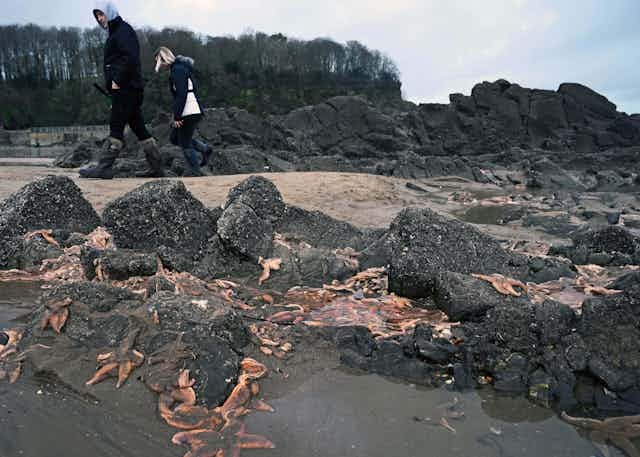Storms this winter have left thousands of starfish lying stranded along the Welsh coast. Many starfish are still alive when they get washed ashore but many will die as they cannot survive being exposed in the air for too long.
Until recently why masses of starfish were suddenly washed ashore was a mystery, but a recent discovery of a starfish behaviour might help explain this phenomena. University of Plymouth scientists devised a novel method of “flying” an underwater video camera to record seabed creatures during big sea swells and strong tidal currents.
The flying video array floats just above the seabed and is towed behind a boat where scientists can watch the video feed live from the boat wheelhouse. While testing the video off Shoreham-by-Sea, West Sussex, during strong tidal currents, the team noticed hundreds of starfish curled up like parachutes, bouncing along the seabed.
Starfish were previously believed to be slow-moving creatures that only crawled over the seabed sticking fast using hundreds of tube feet. Seeing them fly past the screen was an unusual experience but this “starballing” behaviour could explain why the public are suddenly seeing masses of starfish being swept ashore. As they are flying along in big groups, those groups may get swept together on to beaches by storms.
What is starballing?
Very little is known about this “starballing” behaviour of the UK common starfish Asterias rubens, where they roll along the seabed. However, since the discovery mentioned above, US scientists have found that sea cucumbers – a close relative of starfish – also exhibit this behaviour during strong tidal currents.
The mechanism is called “active buoyancy adjustment” and is a behavioural response to environmental changes such as increasing water currents which prompts the animal to increase its body volume becoming bloated, retracting its tentacles and detaching from the seabed.
This allows starfish to be efficiently swept away to new feeding grounds or relocate to breed. It is likely to be a risky method of transport if the strong currents co-occur with strong onshore winds and waves that could take them ashore. This new behaviour could explain starfish mass strandings.
There is still so much still to learn about the behaviour of marine creatures. This particular behaviour only occurs during strong water currents when, typically, no one can observe it. Lively sea conditions reduce water visibility and make conditions more dangerous and challenging for scuba diving and underwater video surveys, making it harder for scientists to research. This behaviour was only recorded as researchers were working during strong spring tides to test new equipment. However, commercial scuba divers have since reported also seeing starfish tumbling along the seabed in both Wales and Scotland during strong tidal currents in 2017.
Reports of mass strandings do seem to be increasing each year and research is needed to see if that might be linked to climate change affecting the weather. UK storms are predicted to increase in frequency and magnitude and that could cause more of this to happen in the future.
Read more: Climate change is making ocean waves more powerful, threatening to erode many coastlines
Extreme storms in the Lyme Bay Marine Protected Area, on the south coast of England, had a devastating impact on the seabed during the winter of 2014. Prior to the storms the area was thriving having been protected for five years from bottom-towed fishing, a practise that uses heavy net or chains to drag the sea floor. Reef species such as pink sea fans, scallops, sponges and corals were flourishing. Sadly, the storms brought huge amounts of sand that devastated this recovering community, wiping out many marine animals. One of the few species to cope with the storms were starfish, possibly by using the starballing technique. They were one of the few creatures to increase in abundance following the storms. The starfish, carnivores who voraciously feed on clams and other slow moving seabed creatures, may also have taken the opportunity to eat the animals that didn’t stand up so well to the storms.
As more starfish are reported coming ashore in large numbers in the UK each year it becomes increasingly important to understand further what is driving these events and why.

